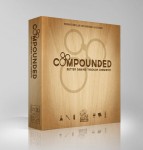 In the resource management game Compounded players use elements one would find in an ordinary high school chemistry lab to create compounds to earn points. It sounds simple, but there are more mechanics involved that can change the game every time you play. One of these allows the players to barter among themselves. To further the degree of strategy involved there is a random factor to the game providing twists and turns in the critical thinking process of the players planning.
In the resource management game Compounded players use elements one would find in an ordinary high school chemistry lab to create compounds to earn points. It sounds simple, but there are more mechanics involved that can change the game every time you play. One of these allows the players to barter among themselves. To further the degree of strategy involved there is a random factor to the game providing twists and turns in the critical thinking process of the players planning.
There isn’t a lot of set up to the game, which I always find to be a plus. Basically you will lay out the periodic table so all players can access it. Then you will layout compound cards. To do this you will first lay out the staring compounds, there are nine of them. You follow that up with 7 random compounds. The rules show the cards laid out in a 4×4 grid. Then each player receives a workbench. The workbench is effectively the players calculator it always shows them what they currently have available to work with. It also has information on the phases and special equipment like safety glasses.
Each compound card is a basically a map for a compound. Some of these compounds are quite simple requiring only a few elements to complete pattern. Others are quite complicated requiring five or six elements in combination. All compound cards have a score on them. Some have special mechanics on them like a flame symbol.
The game is turn based. Each turn consists of rounds where each player takes turns moving through four phases Discovery, Study, Research, and Lab. Each phase allows the player to perform different actions most of these move at a pretty quick pace. In the discovery phase the player can draw and trade elements with other players. During the study phase the player may place and move claim tokens. The research phase allows players to place or swap elements. The Lab phase is the scoring phase.
A player starts their turn by discovering elements. This is done by drawing elements from a sack. The elements involved in the game are sulfur, calcium, carbon, nitrogen, oxygen, and hydrogen. Then the player may barter, this is one of the more fun aspects of the game. There are no real guidelines for the trades, so some pretty odd alliances can be formed. Once all of the players have worked through the phase they move on to the second phase and claim compounds and or move existing claims. Each player has the option of doing this before moving on. The third phase is where the game really kind of comes to life. Players get to place elements on compounds. Elements can be placed on any compounds, claimed or unclaimed. They may only score compounds that they have already claimed. So it is feasible to have a compound on the table that can not be scored if it gets full. Once a claimed compound has filled all its elements it can be scored in the lab phase.
Well that is a basic overview. When I first looked at the rulebook I was a bit overwhelmed but the game is far easier to comprehend than the it would seem. We were actually playing within 30 minutes of reading the rules. The balance between the game mechanics makes the game a smooth flowing transition from player to player. Bartering, in my opinion, seems to be one of the most crucial elements to the game. If you had to rely on the draw the game would move at a much slower pace and therefore boring. There is enough planning and critical thinking involved in the game that it is challenging, and tense. It isn’t always easy to thwart the other players if they constantly barter with each other. The game needs this tension though. Without the haggling it would have lost a a key concept that reinforces the competition. I think my favorite part of the game was the lab fire. It was awesome to watch the explosion, even if it is only metaphoric. When there is a lab fire a compound explodes shooting its elements onto other compounds adjacent to it.
All in all Compounded is a pretty good resource management game that provides players with mechanics that allow them to put a twist on traditional resource management games. It challenges the players to think ahead while plotting and bartering with others. It is safe to say this isn’t a cutthroat game where there is no mercy. I would say it is more of a semi- cooperative game that allows for certain mixes of the game mechanics to be volatile. We have had fun every time our family has played and we believe we will have fun every time we play.




Sorry, the comment form is closed at this time.